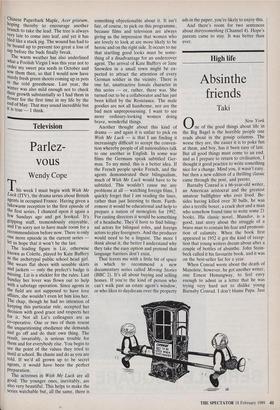Gardens
The hounds of spring
Ursula Buchan
Like most gardeners, I have a notor- iously unreliable memory. Why else do I insist that the wisteria took seven years to flower when my husband knows it was only five, or plant Crocosmia next to Physoste- gia, or infallibly stab lily bulbs with my fork when tidying up the borders? So when I say that I cannot remember a February when I have been so forward with my gardening, you are not obliged to believe me unless what I say accords with your own, equally suspect, experience. At this moment, in early February, my borders are already weeded and mulched with spent mushroom compost, and broad beans are sown, the greenhouse cleaned, the apple trees pruned, the roses tied in and many plants split and replanted. My smugness knows no bounds.
My progress surprises me when I think that I fell victim to two arduous bouts of flu in the warm, dry weather before and after Christmas. (To contract one bout may be regarded as a misfortune; to contract two....) These left me with a debilitating cough and a near-fatal addiction to Neigh- bours. Yet despite everything, I think I have never been in such complete control at the start of the season.
Thank you very much, but I've already got one.' It is the weather which has been nlY salvation. If my memory does not deceive me, this is the mildest winter since 1975, a miraculous year when Iris danfordiae was flowering on 4 January at Wisley and the first daffodil 11 days later. In fact, I am told that this winter has been even warmer, so I suppose that the reason why my Iris danfordiae did not open this year until the end of January, and the first daffodil on 7 February, points to nothing more signifi- cant than the considerable meteorological distance between Surrey and north-east Northamptonshire. Unlike most gardeners, I have no wish to join the 'We'll have to pay for this later on, with frosted fruit blossom and dieback on the roses' party. Even if we do have to `pay' for it later, I shall still have enjord this winter more than any other I can remember, or anyway since 1963 when the snow put an end to hockey for a whole term. The gardening has been agreeable In the sunshine and the flowering has been prodigious and unusually prolonged.
The Algerian iris, Iris unguicularis known as Iris stylosa) unfurls several new scented pale blue-mauve flowers each day in a south-facing wall border and is now joined by the most reliable bulbous irises, I. histroides 'Major' and I. reticulata in its several forms from pale blue to reddish- purple. I wish now that I grew more adventurous, and expensive, forms of I snowdrop in such a good snowdrop year. It would be fun to have `Atkinsii', 'Brenda Troyle' and 'Sam Arnott', which are to the puny common Galanthus nivalis what the Brobdingnagians were to poor old Gulliv- er. Hellebores, both Christmas and Len- ten, are flowering together, the latter (of which I have several spotted and non- spotted, red, pink, and greenish-white forms) set to keep going until April. A kind of winter-flowering blue anemone, Hepatica transsilvannica, has been out for nearly two months and shows no sign of flagging. Of the shrubs' flowering there has been no end, or not for weeks and weeks: wintersweet, viburnums, even the humble winter jasmine has excelled itself. It was, of course, in anticipation, but no great expectation, of just such a winter that I have for years been planting all those things which are normally rain-sodden, slug-chewed, frosted into a brown flimsy and, worst of all, niggardly in their flower- ing.
Although I do not wish to irritate anyone in western Scotland, I do have to admit that the particularly low winter rainfall here has helped me a great deal. Not only has my soil been workable every day but my woolly-leaved alpines should live to see the spring, rather than being sent to their long home by the dankness of the average winter.
The early start into growth has taken me by surprise, I confess. For example, on 3 February, thinking the tree still dormant, I cut a small branch from an eight-year-old
Chinese Paperbark Maple, Acer griseum, hoping thereby to encourage another branch to take the lead. The tree is always very late to come into leaf, and yet it has bled like a stuck pig. The wound has had to be bound up to prevent too great a loss of sap before the buds finally break. The warm weather has also underlined what a Foolish Virgin I was this year not to order my sweet pea seeds in October and sow them then, so that I would now have sturdy fresh green shoots coming up in pots ln the cold greenhouse. Last year, the Winter was also mild enough not to check their growth substantially so I had them in flower for the first time in my life by the end of May. That may sound incredible but it is true — I think.



















































 Previous page
Previous page